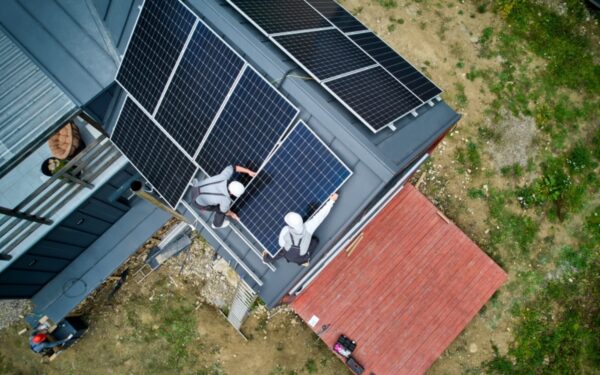Last spring I visited the Pennines. It is as bleak a landscape as you’ll find anywhere in Britain, until you arrive at a place called Geltsdale, where the tenant farmer decided ten years ago to swap his intensive sheep enterprise for a herd of native longhorn cattle.
The family that farms Geltsdale had seen how sheep in large numbers strip the land bare, leaving little or no habitat for wildlife, and turning whole hillsides into green deserts. Managing several thousand sheep had been hard, relentless work, and there was no longer a decent living to be made in that kind of intensive upland sheep farming anyway, even with generous support from the EU’s Common Agriculture Policy. So they decided to do something new, selling off the sheep, and switching to the production of traditional, extensively-grazed beef, and a wilder way of farming.
Turning into this remote and ruggedly beautiful north Cumbrian farm after a long drive through the surrounding landscape was like moving from black and white into technicolour. It is as if the hills and valleys here are reawakening after a long sleep. The hillside is dotted with emergent hawthorn, dog rose and blackthorn scrub and little rowan, birch, oak and trees of all kinds are popping up everywhere. A small river fringed with the fresh growth of willow, aspen and alder babbles through a valley-bottom vivid with wildflowers.
Amid the melancholic call of curlews wheeling overhead, a sound that has all but disappeared from much of Britain, the birdsong from one patch of scrub at Geltsdale to the next is riotous. The place just teems with life in a way that is quite different to most of upland Britain. The historian AJP Taylor once said: “When we peer into the future we see the past”. This magical place offers a glimpse not only of a past steeped in tradition and rich natural abundance, but of a future in which wilder farming breathes new life into the shattered ecology and economy of Britain’s marginal lands.
The notion of “rewilding” has risen in the public consciousness recently. And more and more people have seen for themselves the results of initiatives such as the extraordinary Knepp Rewilding Project in Sussex. Two decades ago Isabella Tree and her husband Charlie Burrell made the momentous decision to give up what had become a hopeless battle to make a success of intensive arable and dairy farming on their 3,000 acres of heavy clay land, and to hand their farm over to nature. The astonishing resurgence that took place when they turned out a herd of free-roaming longhorn cattle, a family of Exmoor ponies and some Tamworth pigs is laid out in Isabella’s blockbuster bestseller Wilding, which describes the miraculous return of species that are disappearing almost everywhere else: Turtle doves, nightingales, white storks, kingfishers, purple emperor butterflies, species of all kinds are present at Knepp in unfathomable numbers. The beauty of the project is how little human interference was needed for the transformation to happen. The Knepp project has turned nature conservation in Britain on its head.
Now the charity Rewilding Britain is campaigning for a similar approach across more than a million hectares of land – five per cent of the entire country – by 2100.
Not everyone is convinced by the new rewilding “movement”. Earlier this year a disparaging newspaper headline complained of “trendy metropolitan eco-zealots” “driving out traditional farming” via rewilding. The fear of some critics is that ambitious nature restoration represents a threat to the traditional farming communities that have managed our remoter landscapes for centuries, and could even lead to their disappearance altogether. Nothing could be further from the truth. Traditional farming is essential to the process of nature recovery on agriculturally marginal land. That’s why the term “wilder farming”, rather than “rewilding”, may be a better way to describe the changes so many people long to see across swathes of Britain.
Most of us are conscious that the natural fabric of our country has been degraded and depleted over the centuries, but few realise the full extent of the catastrophe that has unfolded around us, particularly in recent decades. Depressingly, the UK now ranks among the most nature impoverished nations. Expectations diminish from one generation to the next as we become conditioned to what we know in our own lifetimes, in a process known as shifting baselines, so that most of us have no inkling of the extent of our losses.
Countless species have vanished altogether, and those that do remain frequently exist in isolated, often tiny fragments of remnant nature, largely thanks to the care of a handful of dedicated nature-friendly farmers and conservationists. Personal accounts from earlier centuries describe seas teeming with life, meadows and woodland glades carpeted in wildflowers, hedgerows and woodland thronged with songbirds. That’s why rewilding has captured the public imagination. It offers a route, for the first time, to meaningful, landscape-scale nature restoration; a way to start reversing the losses.
Farming has deep cultural significance in Britain, and it is farmers who are often best placed to breathe life back into the landscape. For the last 40 years or so the EU’s Common Agriculture Policy has doled out billions of pounds in subsidies to farmers, largely without condition. The way these payments are allocated encourages farmers to work every square inch of their land, no matter how suitable for food production. Trees, wetlands, pockets of scrub, ponds are all deemed “ineligible features.” If farmers want to keep the money flowing, they must remove these important habitats. For nature, this has been a disaster. Brexit offers the opportunity now for the UK to replace a subsidy of perverse incentives with something so much better. Under the new Agriculture Bill farmers will be directly rewarded for restoring nature on their land. “Public money for public good” is the term used to describe the new approach.
Across most of Britain, especially in our upland landscapes, intensive farming is simply not viable without oodles of subsidy. The environmental cost of trying to make it work has been catastrophic. Millions of sheep have almost entirely stripped hills and valleys of their green mantle. With the exception of small pockets, trees, scrub, wildflowers, birdsong are largely absent. People think of our upland National Parks as great nature reserves, but they are not. Sadly, there is often less wildlife in these parts of the UK than in surrounding areas. Perhaps it is no surprise that not a single one of our upland areas makes the Telegraph’s annual bucket list. In any other country the uplands would be at or near the top of such a list – but in Britain we have lost our wild places.
One of the consequences is flooding. The science is crystal clear (unlike the water in our rivers): if you strip the hills of nature you significantly exacerbate the cycle of flash-flooding and seasonal drought. Bare hills are simply unable to absorb and hold back water after heavy rainfall. Taxpayers are forking out twice to maintain the status quo – in the form of farm subsidies, and then again in the huge costs associated with mitigating and insuring against flooding, and in clearing up the mess when conventional flood mitigation fails.
Perhaps the worst part of the story is that environmental decline across our marginal landscapes has gone hand in hand with economic and social decline. Even with hand-outs from the EU, trying to farm intensively just does not pay. As the average age of hill farmers creeps ever higher, Britain’s upland communities are dwindling.
In the same way that a medieval bridge is supported by several keystones, without which the bridge collapses, it is understood that the ecological health of our landscapes depends upon the activities of so-called keystone species. In Britain the four keystones are believed to be the native cattle (or their wild predecessors the aurochs and the bison), the pig (or its ancestor the wild boar), the beaver and the wolf. The removal of each of these in turn has triggered ecological collapse across the British uplands – and most notably in the fabled Highlands of Scotland, probably the most ecologically degraded landscape in all Europe.
The wolf – whose role we do our best to fulfil ourselves – keeps in check the number of grazing animals on the mountain.
The engineering work carried out by beavers ensures a healthy relationship between land and water.
The pig, nature’s gardener, turns the soil in its incessant rootling, opening the ground for the benefit of wildflowers and songbirds alike.
And the browsing, grazing and trampling of native cattle prevents the darkness of the tree canopy from closing over the landscape. The outcome is the kind of dynamic wood pasture which once blanketed much of Britain, complete with scrub and rich in wildflowers, a mosaic of different habitats which teems with life in an abundance that we are unused to experiencing today.
All we need do is incentivise a way of farming in these landscapes which recreates these fundamental natural processes. A ground-breaking economic study of upland livestock farming shows how extensive grazing of livestock and the recovery of nature delivers significantly improved economic resilience for marginal farming businesses. If we incentivise farmers to make this transition, a bonus will be the growth of nature tourism. This has huge additional potential in wilder landscapes and has grown to be the mainstay of rural economies across much of Europe. Some visionary farmers, such as the Horned Beef Company, are already blazing a trail, showing that this works. The results can be extraordinary.
Wilder farming is as close to a silver bullet for the future management of our marginal lands as we’ll find. It is time to embrace this new way.




